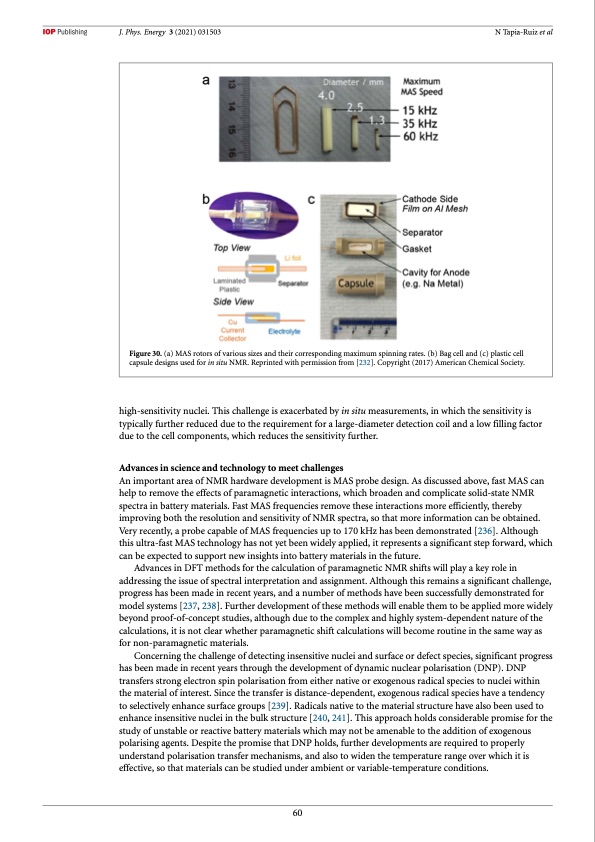
PDF Publication Title:
Text from PDF Page: 061
J. Phys. Energy 3 (2021) 031503 N Tapia-Ruiz et al Figure 30. (a) MAS rotors of various sizes and their corresponding maximum spinning rates. (b) Bag cell and (c) plastic cell capsule designs used for in situ NMR. Reprinted with permission from [232]. Copyright (2017) American Chemical Society. high-sensitivity nuclei. This challenge is exacerbated by in situ measurements, in which the sensitivity is typically further reduced due to the requirement for a large-diameter detection coil and a low filling factor due to the cell components, which reduces the sensitivity further. Advances in science and technology to meet challenges An important area of NMR hardware development is MAS probe design. As discussed above, fast MAS can help to remove the effects of paramagnetic interactions, which broaden and complicate solid-state NMR spectra in battery materials. Fast MAS frequencies remove these interactions more efficiently, thereby improving both the resolution and sensitivity of NMR spectra, so that more information can be obtained. Very recently, a probe capable of MAS frequencies up to 170 kHz has been demonstrated [236]. Although this ultra-fast MAS technology has not yet been widely applied, it represents a significant step forward, which can be expected to support new insights into battery materials in the future. Advances in DFT methods for the calculation of paramagnetic NMR shifts will play a key role in addressing the issue of spectral interpretation and assignment. Although this remains a significant challenge, progress has been made in recent years, and a number of methods have been successfully demonstrated for model systems [237, 238]. Further development of these methods will enable them to be applied more widely beyond proof-of-concept studies, although due to the complex and highly system-dependent nature of the calculations, it is not clear whether paramagnetic shift calculations will become routine in the same way as for non-paramagnetic materials. Concerning the challenge of detecting insensitive nuclei and surface or defect species, significant progress has been made in recent years through the development of dynamic nuclear polarisation (DNP). DNP transfers strong electron spin polarisation from either native or exogenous radical species to nuclei within the material of interest. Since the transfer is distance-dependent, exogenous radical species have a tendency to selectively enhance surface groups [239]. Radicals native to the material structure have also been used to enhance insensitive nuclei in the bulk structure [240, 241]. This approach holds considerable promise for the study of unstable or reactive battery materials which may not be amenable to the addition of exogenous polarising agents. Despite the promise that DNP holds, further developments are required to properly understand polarisation transfer mechanisms, and also to widen the temperature range over which it is effective, so that materials can be studied under ambient or variable-temperature conditions. 60PDF Image | 2021 roadmap for sodium-ion batteries

PDF Search Title:
2021 roadmap for sodium-ion batteriesOriginal File Name Searched:
roadmap-sodium-ion-batteries_031503.pdfDIY PDF Search: Google It | Yahoo | Bing
Salgenx Redox Flow Battery Technology: Salt water flow battery technology with low cost and great energy density that can be used for power storage and thermal storage. Let us de-risk your production using our license. Our aqueous flow battery is less cost than Tesla Megapack and available faster. Redox flow battery. No membrane needed like with Vanadium, or Bromine. Salgenx flow battery
| CONTACT TEL: 608-238-6001 Email: greg@salgenx.com | RSS | AMP |